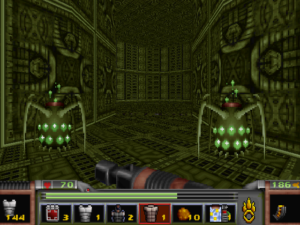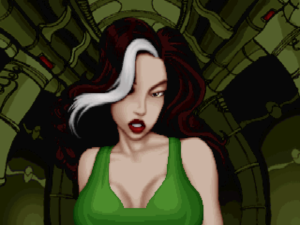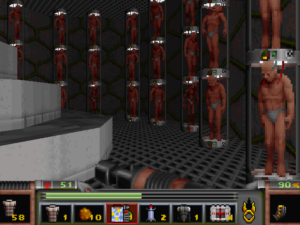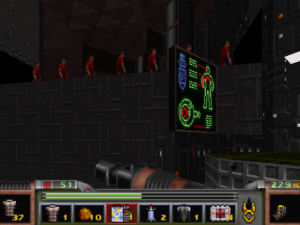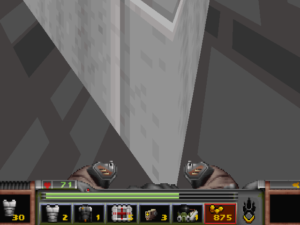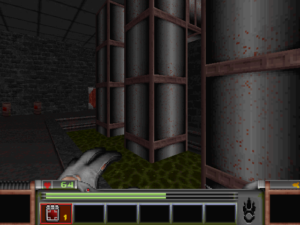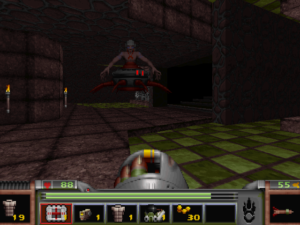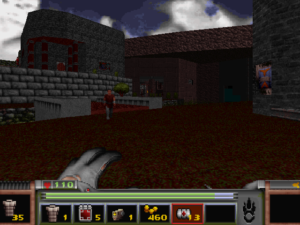Kingdom of Loathing
 It’s now been well over two weeks since my last post. I didn’t plan to take a break from the Stack, but it happened anyway, so I think I should take a moment to talk about how I’ve been spending my gaming hours lately. I’ve been playing Kingdom of Loathing, the humorous free browser-based RPG with stick-figure art and surprisingly deep gameplay, for… ye gods, the in-game stats say it’s been four years. I haven’t been playing it steadily over that time — I’ve taken substantial breaks — but lately I’ve been giving it a lot of attention.
It’s now been well over two weeks since my last post. I didn’t plan to take a break from the Stack, but it happened anyway, so I think I should take a moment to talk about how I’ve been spending my gaming hours lately. I’ve been playing Kingdom of Loathing, the humorous free browser-based RPG with stick-figure art and surprisingly deep gameplay, for… ye gods, the in-game stats say it’s been four years. I haven’t been playing it steadily over that time — I’ve taken substantial breaks — but lately I’ve been giving it a lot of attention.
The main audience for this blog has probably had some exposure to KoL already, but in case you haven’t, let me start by describing the mechanics a little. The main thing you do in the game, as in most CRPGs, is fight stuff. You initiate contact with monsters by choosing a zone on a map: with a couple of exceptions, there’s no exploration within encounter zones, just randomly-chosen monsters appropriate to the zone. (The Goatlet, for example, is populated exclusively by various kinds of goat, while the Misspelled Cemetary has skeltons and zobmies and the occasional grave rober.) Each encounter uses up one turn, or “adventure”, as they call them here (probably to more easily distinguish them from combat rounds). By default, every player gets 40 adventures per day, but there are ways to get more: certain items grant more adventures at rollover when equipped or installed in your campground, and consuming food and drink will grant a number of immediate extra adventures depending on its quality. (Cooking is an important skill in the game for improving the quality of food and thus getting more adventures out of it. Cocktailcrafting does likewise for beverages, producing ones with a better adventures/intoxication ratio. At the more advanced levels, Cocktailcrafting lets you enhance drinks by means of special ingredients like little paper umbrellas and coconut shells.) This whole system is a fairly brilliant bit of design, if you ask me. Most multiplayer games have a flaw that they wind up being (perceived as) “unfair” to casual players, and dominated by the few who are obsessed enough to spend all day playing. KoL gets around this by making it impossible to play all day, 1Unless you use multiple characters, which is frowned upon and considered an abuse by the developers. but still provides some leeway for the dedicated enthusiasts to play longer. Enthusiasm has an effect, but it’s capped.
The overall goal of the game is to rescue King Ralph XI, who has been kidnapped by the Naughty Sorceress. Once you do this, you can “ascend” and start over from level 1, using a different character class if you desire. Ascension is not mandatory, and you can just keep on gaining levels if you want, but there are certain advantages to it: ascending players get to choose one skill to keep permanently (thus letting you have skills from more than one class simultaneously, like in the FF5 Jobs system), and may receive other rewards on the basis of voluntary restrictions. If you choose to go “hardcore” for an ascension, for example, you don’t get access to your items from previous runs — they’re kept in a mini-storage unit until you free the King. Your reward for completing a hardcore run is a special piece of stainless steel equipment, determined by your class. Swear off food and drink as well (that is, become “oxygenarian” for an ascension) and you get an even better item, forged from plexiglass.
Although each player proceeds through the plot of the game independently, there is a certain amount of interaction between players. Players can open stores in the Mall of Loathing to sell items to each other, cast spells to buff each other, create “clans” to share resources. The most recent big development in the game was the addition of Hobopolis, a dungeon designed for a clan to tackle as a group. The mechanics of the game mean that you’re basically adventuring solo all the time, but your actions in Hobopolis can have effects for everyone in your clan.
Hobopolis is one of two recent developments that got me investing more time in the game than usual. The other starts with the Traveling Trader. The Trader is a sort of special event: once every few months, he shows up for a day, always with one new item to sell. Sometimes it’s good, sometimes it’s bad, but always he leaves with his wares at rollover. Back in January, for example, he was selling “strange shiny discs” for the exhorbitant price of 10 Twinkly Wads apiece. 2Wads, which come in several flavors, are kind of like concentrated magic, and are mainly obtained by pulverizing powerful magic items. They can then be forged into new items, or simply eaten. The discs had no obvious use, and looked suspiciously like AOL CDs 3The first letter on the label was smudged, raising some suspicion that it actually read “KOL”., but I bought one anyway, figuring it might be a setup for something later.
And it was. Three weeks ago, the Travelling Trader showed up again, selling a book called Rainbow’s Gravity, which contained the secrets to a new skill, one that lets you take one of each type of wad and smush them together into a Prismatic Wad. The price for this book: 50 strange shiny discs.
Now, I felt a little put out by that. I probably could have obtained 50 discs when they were available if I had known that I would need that many, but I had only bought one. So I felt like I should have this skill, but had been denied it. There were shiny discs available in the Mall, of course, but with the demand for them what it was on that day, I couldn’t possibly afford enough to buy the book. (I did, however, manage to make a small profit by buying some discs from the shops owned by players who hadn’t yet heard that they were suddenly valuable, and putting them in my own shop at a markup.) The book itself also started showing up in people’s shops in short order, but the asking price teetered around 6 million meat.
(I should explain: Meat is the main currency in the game. 4There are a few other kinds of money that are only usable in specific situations. For example, bounty hunting gives you Filthy Lucre, which can only be spent on special bounty-hunter items in the bounty-hunter store, and can’t even be traded to other players the way meat can. I imagine this is was developed in reaction to the absurdity found in a lot of RPGs, where you kill a wild animal, such as a wolf, and it drops gold. It is, of course, entirely reasonable that killing the wolf would yield meat. Of course, just swapping “meat” for “gold” creates opposite absurdities, such as when you find meat in treasure chests, but these are absurdities that KoL enthusiastically embraces. At any rate, it’s more or less equivalent to gold pieces as far as gameplay goes, except for the addition that meat can be pounded into meat stacks and used to craft meat-based weapons and armor.)
So. Six million meat. As it happened, I had a couple million on hand already, the remnants from when I sold my stash of Zombie Pineal Glands to buy some Time Trousers (both of which are no longer available except from other players who hoarded them). Could I cover the rest? Well, there are some skills and special items that increase the amount of meat you get from monsters. I don’t have them all yet, but I have most of them, and a little experiment showed that in my current state, I can easily make more than a million a week. I was surprised at this: I’ve been doing most of my recent adventuring in Hardcore Oxygenarian mode, which severely limits one’s ability to get extra adventures and spend them meat-farming. But outside of that mode, I can get upward of 200 adventures per day, and spend most of them hunting the meatiest creatures in the game by means of Transcendent Olfaction — a game-transforming tracking skill, and a recent acquisition for me.  Specifically, I’ve been hunting the Cubist Bulls that show up in the Haunted Gallery. If there’s a more efficient way to meat-farm, I’d like to hear about it — the bulls have one of the highest yields in the game, but you don’t get them all the time even when you’re tracking them, and several of the other monsters in the Gallery yield no meat at all. It’s also possible that I’d be better served by farming for items to sell. Still, just doing as I’m doing, I’m making meat faster than I thought possible.
Specifically, I’ve been hunting the Cubist Bulls that show up in the Haunted Gallery. If there’s a more efficient way to meat-farm, I’d like to hear about it — the bulls have one of the highest yields in the game, but you don’t get them all the time even when you’re tracking them, and several of the other monsters in the Gallery yield no meat at all. It’s also possible that I’d be better served by farming for items to sell. Still, just doing as I’m doing, I’m making meat faster than I thought possible.
Of course, once I started on this course, I started wondering: Is Rainbow’s Gravity really the thing I should be spending all this meat on? There are a host of other items that I’ve generally thought of as out of my reach, mainly Items of the Month. This gets into the game’s revenue model. See, a $10 donation to the developers gets you an accessory called “Mr. Accessory”, which is a pretty nice item in its own right (+15 to all stats, no prerequisites), but which can also be traded at “Mr. Store” for various things. And one of those things is a new thing every month. I personally bought a Mr. Accessory early on in my KoL career, only to have it stolen when some griefer guessed my account password, which left me with a distaste for spending more money. But there are people who send in their $10 every month to get the new item and its associated content — it’s sort of like the monthly fees charged by conventional MMO’s, except completely voluntary. There are even people who buy more than one Item of the Month every month and put the extras up for sale in the Mall for millions of meat. And now that I know that I can produce millions of meat when I want to, these special items suddenly seem accessible.
I still haven’t bought Rainbow’s Gravity — its mall price has declined quite a lot as the Prismatic Wads lost their patina of novelty, and is still going down as of this writing. But I have bought the item from this last May, the Mayflower Bouquet, which seemed like the best buy for its price. I’ll probably go for the Naughty Origami Kit next, but maybe not before I ascend.
In fact, I’ve been fairly well agonizing over the decision of what formerly-unattainable thing to try for next, and when to try for it. A complete list of past Items of the Month can be seen on the KOL Wiki, which is an invaluable resource — as with Nethack, familiarizing yourself with the literature is key to success. 5Incidentally, the developers are familiar enough with Nethack to pay it tribute in a special Nethack-in-joke dungeon, where the monster illustrations are drawings of letters of the alphabet. And there’s a certain commonality of spirit there, of simple presentation on top of complex gameplay. There are also areas that are tributes to, or satires of, early text adventures, the Nintendo Entertainment System, and the Final Fantasy series — in decreasing order of respectfulness. And it’s all too easy, once you’re out of adventures for the day, to spend time poring over the list, checking the prices at the mall, and considering your options.
This reveals something unexpected: the limitation on the number of adventures can actually increase the amount of time spent on the game. In any other game, I’d spend my time actively pursuing my goals. I’d farm until it was possible to buy something, then I’d decide what to buy (if I hadn’t decided already), then I’d buy it. But these forced pauses in gameplay give me endless opportunity to make plans, and then to re-evaluate and reconsider them.
| ↑1 | Unless you use multiple characters, which is frowned upon and considered an abuse by the developers. |
|---|---|
| ↑2 | Wads, which come in several flavors, are kind of like concentrated magic, and are mainly obtained by pulverizing powerful magic items. They can then be forged into new items, or simply eaten. |
| ↑3 | The first letter on the label was smudged, raising some suspicion that it actually read “KOL”. |
| ↑4 | There are a few other kinds of money that are only usable in specific situations. For example, bounty hunting gives you Filthy Lucre, which can only be spent on special bounty-hunter items in the bounty-hunter store, and can’t even be traded to other players the way meat can. |
| ↑5 | Incidentally, the developers are familiar enough with Nethack to pay it tribute in a special Nethack-in-joke dungeon, where the monster illustrations are drawings of letters of the alphabet. And there’s a certain commonality of spirit there, of simple presentation on top of complex gameplay. There are also areas that are tributes to, or satires of, early text adventures, the Nintendo Entertainment System, and the Final Fantasy series — in decreasing order of respectfulness. |
 Comments(2)
Comments(2)